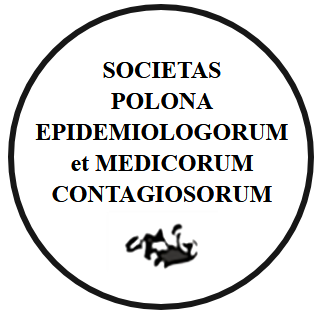Hepatitis B in Poland in 2021
Publication date: 2024-02-02
Przegl Epidemiol 2023;77(3):359-371
KEYWORDS
ABSTRACT
OBJECTIVE.
Evaluation of the epidemiological situation of hepatitis B in Poland in 2021 compared to previous years, considering the impact of the COVID-19 pandemic.
MATERIAL AND METHODS.
Data from individual reports on hepatitis B cases and HBV infections registered by local sanitary and epidemiological stations in the EpiBaza system were analyzed. Aggregate data published in the annual bulletins: “Infectious diseases and poisonings in Poland”, “Vaccinations in Poland” and data on deaths provided by the Demographic Surveys Department of Statistics Poland (GUS) were also used.
RESULTS.
In 2021, a total of 1,547 cases of hepatitis B were registered, including 10 cases of acute hepatitis B, with an incidence of acute hepB 0.03/100,000 population. The incidence of acute hepB was lower by 25% than in 2020 and lower by 75% than the median incidence for 2015-2019. Acute cases occurred only in 6 voivodeships, all in people over 28 years of age. Two out of 10 acute cases were classified as imported. In 2021, 1,537 chronic or unknown-phase cases (UNK) were reported and registered, the diagnosis rate was 4.03/100,000 and was higher by 58% than the rate in 2020 and lower by 53% than the median for 2015-2019. The distribution of cases by gender, age and place of residence was similar to that observed previously – chronic cases or UNK were diagnosed more often in men (male-to-female ratio 1.5:1) and people living in cities. Two chronic infections have been reported in infants born to HBV-infected women. 2.5% of chronic and UNK cases were considered imported. According to Statistics Poland (GUS), 20 people died in 2021, including 3 due to acute hepatitis B. The vaccination coverage of 1-year-olds with 3 doses of hepatitis B vaccine (HepB3) decreased slightly compared to 2020 and amounted to 89.3%.
CONCLUSIONS.
In the second year of the COVID-19 pandemic, a gradual levelling of the sharp decline in the number of diagnosed chronic and UNK cases that occurred in 2020 was observed. In acute cases, a further decline in incidence was noted compared to 2020, but a smaller number of acute cases was most likely due to the lower effectiveness of surveillance during the COVID-19 pandemic, rather than from an improvement in the epidemiological situation. The vaccination coverage of children in the second year of life (born in 2020) with the third dose of HepB vaccine continued to decline, although slightly.
We process personal data collected when visiting the website. The function of obtaining information about users and their behavior is carried out by voluntarily entered information in forms and saving cookies in end devices. Data, including cookies, are used to provide services, improve the user experience and to analyze the traffic in accordance with the Privacy policy. Data are also collected and processed by Google Analytics tool (more).
You can change cookies settings in your browser. Restricted use of cookies in the browser configuration may affect some functionalities of the website.
You can change cookies settings in your browser. Restricted use of cookies in the browser configuration may affect some functionalities of the website.





